Essay: Child Pedagogy: Theory, Practice, and EYLF Framework
VerifiedAdded on 2022/10/08
|8
|2181
|43
Essay
AI Summary
This essay provides a comprehensive overview of child pedagogy, focusing on its theoretical underpinnings and practical applications in early childhood education. It defines pedagogy and its influence by child psychology, exploring aims, objectives, and key principles such as maximizing academic challenges and engaging students. The essay delves into various pedagogical approaches including constructivist, integrative, reflective, collaborative, and inquiry-based methods. It examines core theories like Piaget's Cognitive Development, Kohlberg’s Moral Development, and Vygotsky’s Zone of Proximal Development. Furthermore, the essay analyzes the National Early Years Learning Framework (EYLF) principles of being, belonging, and becoming, and discusses the teacher's role in supporting play and development, including the use of international scaffolding. It concludes by addressing strategies for engaging children in play, emphasizing the importance of enthusiasm, storytelling, and color to foster involvement and address potential challenges like anxiety and shyness. The essay is supported by relevant references.
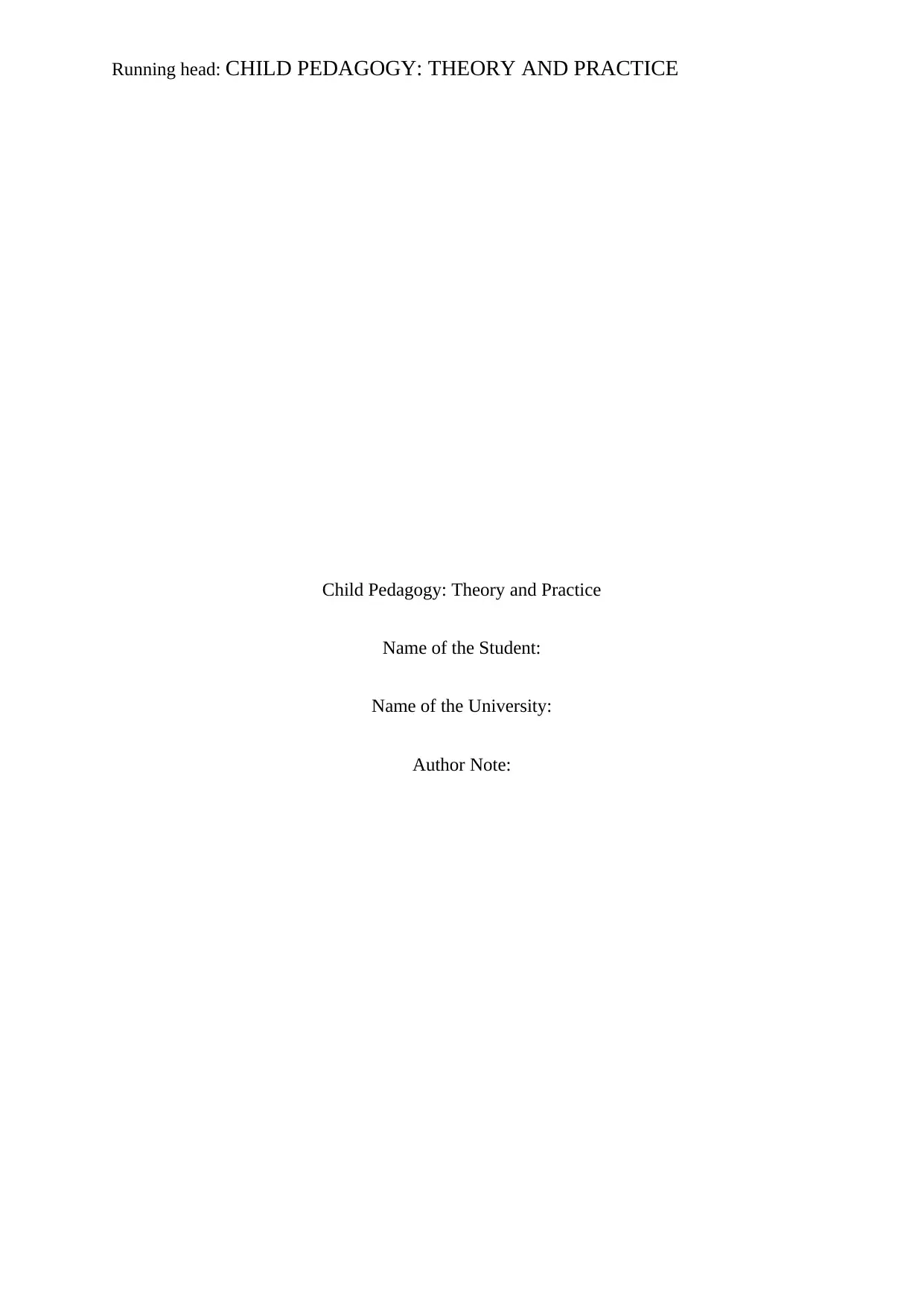
Running head: CHILD PEDAGOGY: THEORY AND PRACTICE
Child Pedagogy: Theory and Practice
Name of the Student:
Name of the University:
Author Note:
Child Pedagogy: Theory and Practice
Name of the Student:
Name of the University:
Author Note:
Paraphrase This Document
Need a fresh take? Get an instant paraphrase of this document with our AI Paraphraser
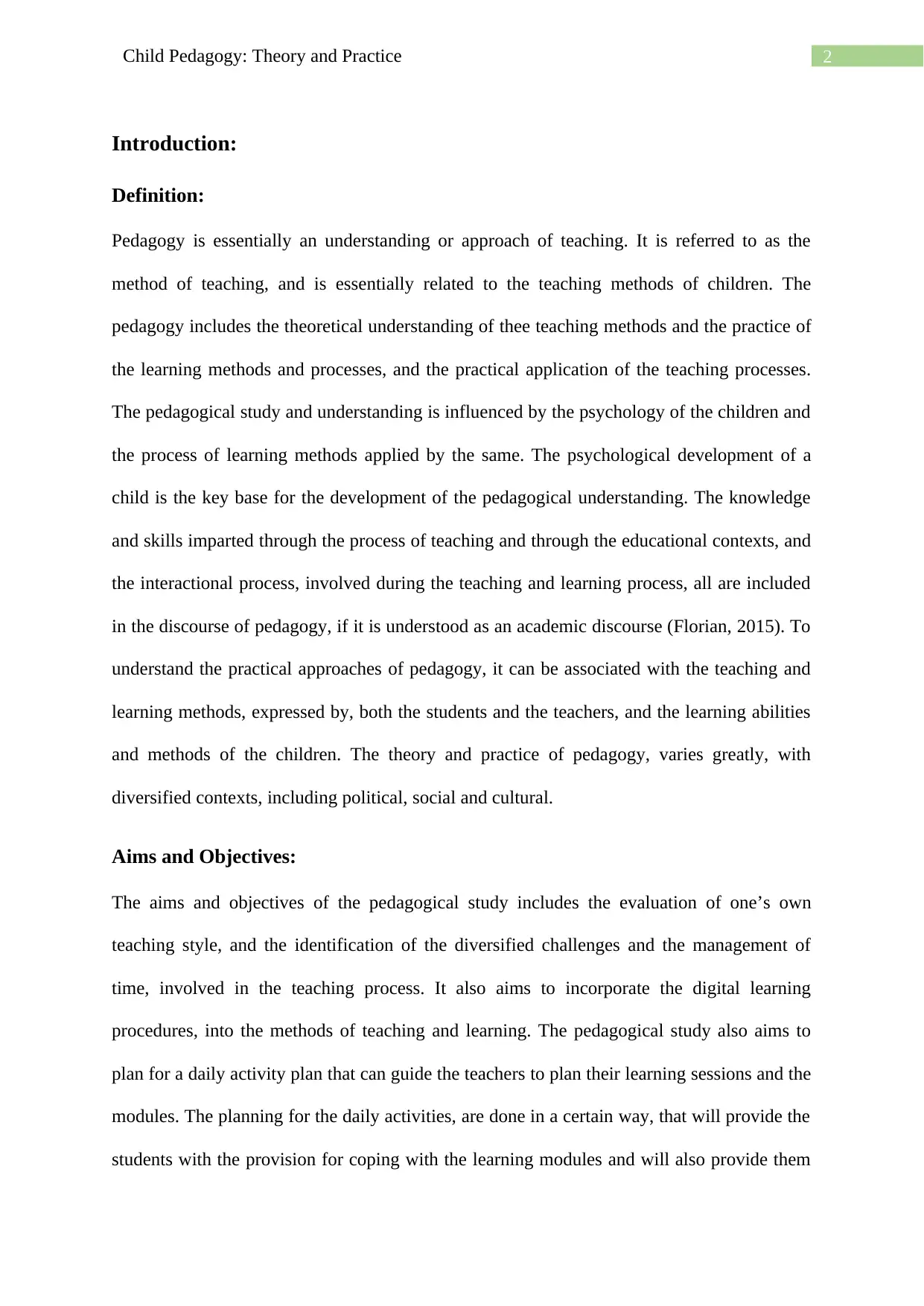
2Child Pedagogy: Theory and Practice
Introduction:
Definition:
Pedagogy is essentially an understanding or approach of teaching. It is referred to as the
method of teaching, and is essentially related to the teaching methods of children. The
pedagogy includes the theoretical understanding of thee teaching methods and the practice of
the learning methods and processes, and the practical application of the teaching processes.
The pedagogical study and understanding is influenced by the psychology of the children and
the process of learning methods applied by the same. The psychological development of a
child is the key base for the development of the pedagogical understanding. The knowledge
and skills imparted through the process of teaching and through the educational contexts, and
the interactional process, involved during the teaching and learning process, all are included
in the discourse of pedagogy, if it is understood as an academic discourse (Florian, 2015). To
understand the practical approaches of pedagogy, it can be associated with the teaching and
learning methods, expressed by, both the students and the teachers, and the learning abilities
and methods of the children. The theory and practice of pedagogy, varies greatly, with
diversified contexts, including political, social and cultural.
Aims and Objectives:
The aims and objectives of the pedagogical study includes the evaluation of one’s own
teaching style, and the identification of the diversified challenges and the management of
time, involved in the teaching process. It also aims to incorporate the digital learning
procedures, into the methods of teaching and learning. The pedagogical study also aims to
plan for a daily activity plan that can guide the teachers to plan their learning sessions and the
modules. The planning for the daily activities, are done in a certain way, that will provide the
students with the provision for coping with the learning modules and will also provide them
Introduction:
Definition:
Pedagogy is essentially an understanding or approach of teaching. It is referred to as the
method of teaching, and is essentially related to the teaching methods of children. The
pedagogy includes the theoretical understanding of thee teaching methods and the practice of
the learning methods and processes, and the practical application of the teaching processes.
The pedagogical study and understanding is influenced by the psychology of the children and
the process of learning methods applied by the same. The psychological development of a
child is the key base for the development of the pedagogical understanding. The knowledge
and skills imparted through the process of teaching and through the educational contexts, and
the interactional process, involved during the teaching and learning process, all are included
in the discourse of pedagogy, if it is understood as an academic discourse (Florian, 2015). To
understand the practical approaches of pedagogy, it can be associated with the teaching and
learning methods, expressed by, both the students and the teachers, and the learning abilities
and methods of the children. The theory and practice of pedagogy, varies greatly, with
diversified contexts, including political, social and cultural.
Aims and Objectives:
The aims and objectives of the pedagogical study includes the evaluation of one’s own
teaching style, and the identification of the diversified challenges and the management of
time, involved in the teaching process. It also aims to incorporate the digital learning
procedures, into the methods of teaching and learning. The pedagogical study also aims to
plan for a daily activity plan that can guide the teachers to plan their learning sessions and the
modules. The planning for the daily activities, are done in a certain way, that will provide the
students with the provision for coping with the learning modules and will also provide them
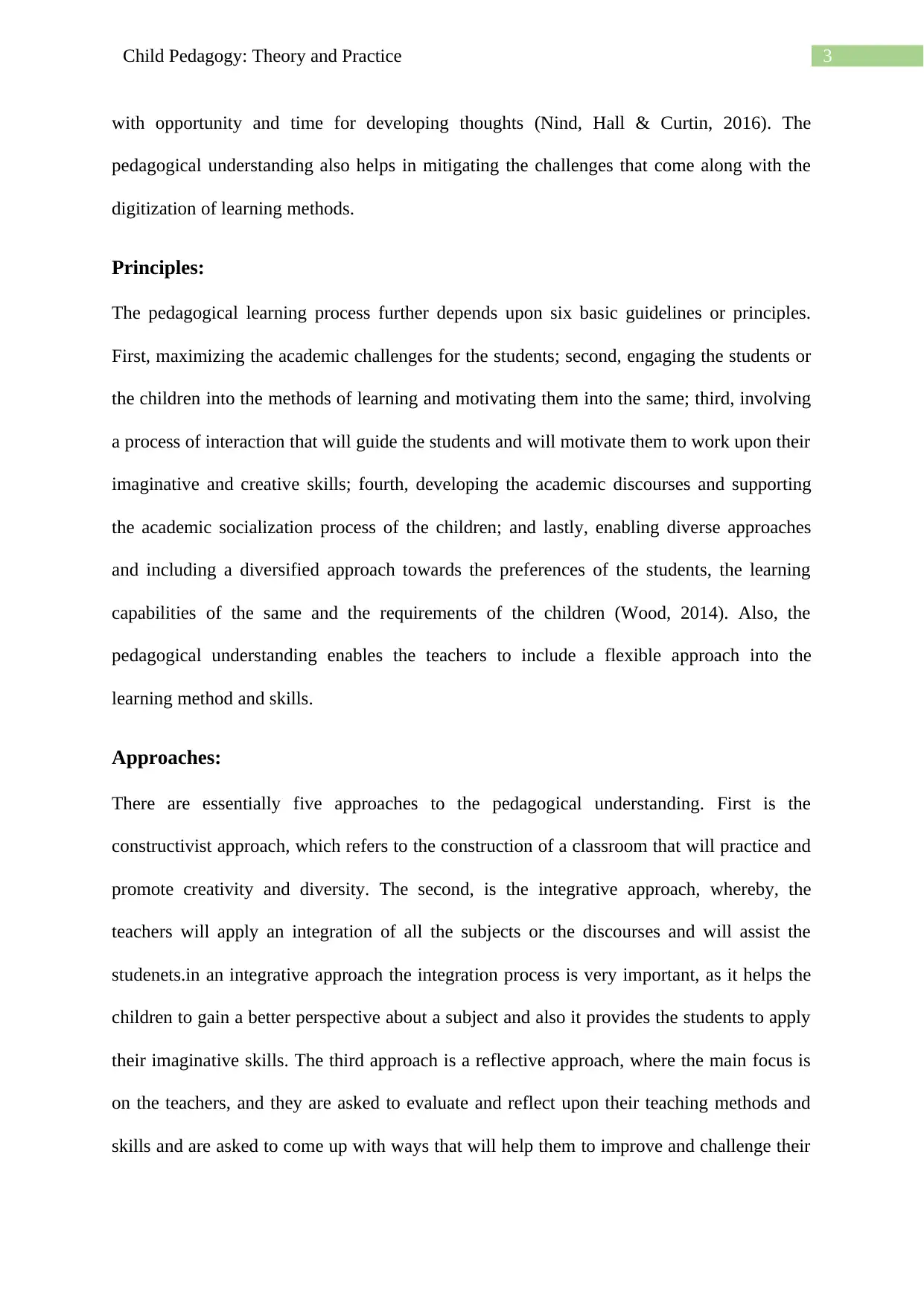
3Child Pedagogy: Theory and Practice
with opportunity and time for developing thoughts (Nind, Hall & Curtin, 2016). The
pedagogical understanding also helps in mitigating the challenges that come along with the
digitization of learning methods.
Principles:
The pedagogical learning process further depends upon six basic guidelines or principles.
First, maximizing the academic challenges for the students; second, engaging the students or
the children into the methods of learning and motivating them into the same; third, involving
a process of interaction that will guide the students and will motivate them to work upon their
imaginative and creative skills; fourth, developing the academic discourses and supporting
the academic socialization process of the children; and lastly, enabling diverse approaches
and including a diversified approach towards the preferences of the students, the learning
capabilities of the same and the requirements of the children (Wood, 2014). Also, the
pedagogical understanding enables the teachers to include a flexible approach into the
learning method and skills.
Approaches:
There are essentially five approaches to the pedagogical understanding. First is the
constructivist approach, which refers to the construction of a classroom that will practice and
promote creativity and diversity. The second, is the integrative approach, whereby, the
teachers will apply an integration of all the subjects or the discourses and will assist the
studenets.in an integrative approach the integration process is very important, as it helps the
children to gain a better perspective about a subject and also it provides the students to apply
their imaginative skills. The third approach is a reflective approach, where the main focus is
on the teachers, and they are asked to evaluate and reflect upon their teaching methods and
skills and are asked to come up with ways that will help them to improve and challenge their
with opportunity and time for developing thoughts (Nind, Hall & Curtin, 2016). The
pedagogical understanding also helps in mitigating the challenges that come along with the
digitization of learning methods.
Principles:
The pedagogical learning process further depends upon six basic guidelines or principles.
First, maximizing the academic challenges for the students; second, engaging the students or
the children into the methods of learning and motivating them into the same; third, involving
a process of interaction that will guide the students and will motivate them to work upon their
imaginative and creative skills; fourth, developing the academic discourses and supporting
the academic socialization process of the children; and lastly, enabling diverse approaches
and including a diversified approach towards the preferences of the students, the learning
capabilities of the same and the requirements of the children (Wood, 2014). Also, the
pedagogical understanding enables the teachers to include a flexible approach into the
learning method and skills.
Approaches:
There are essentially five approaches to the pedagogical understanding. First is the
constructivist approach, which refers to the construction of a classroom that will practice and
promote creativity and diversity. The second, is the integrative approach, whereby, the
teachers will apply an integration of all the subjects or the discourses and will assist the
studenets.in an integrative approach the integration process is very important, as it helps the
children to gain a better perspective about a subject and also it provides the students to apply
their imaginative skills. The third approach is a reflective approach, where the main focus is
on the teachers, and they are asked to evaluate and reflect upon their teaching methods and
skills and are asked to come up with ways that will help them to improve and challenge their
⊘ This is a preview!⊘
Do you want full access?
Subscribe today to unlock all pages.

Trusted by 1+ million students worldwide
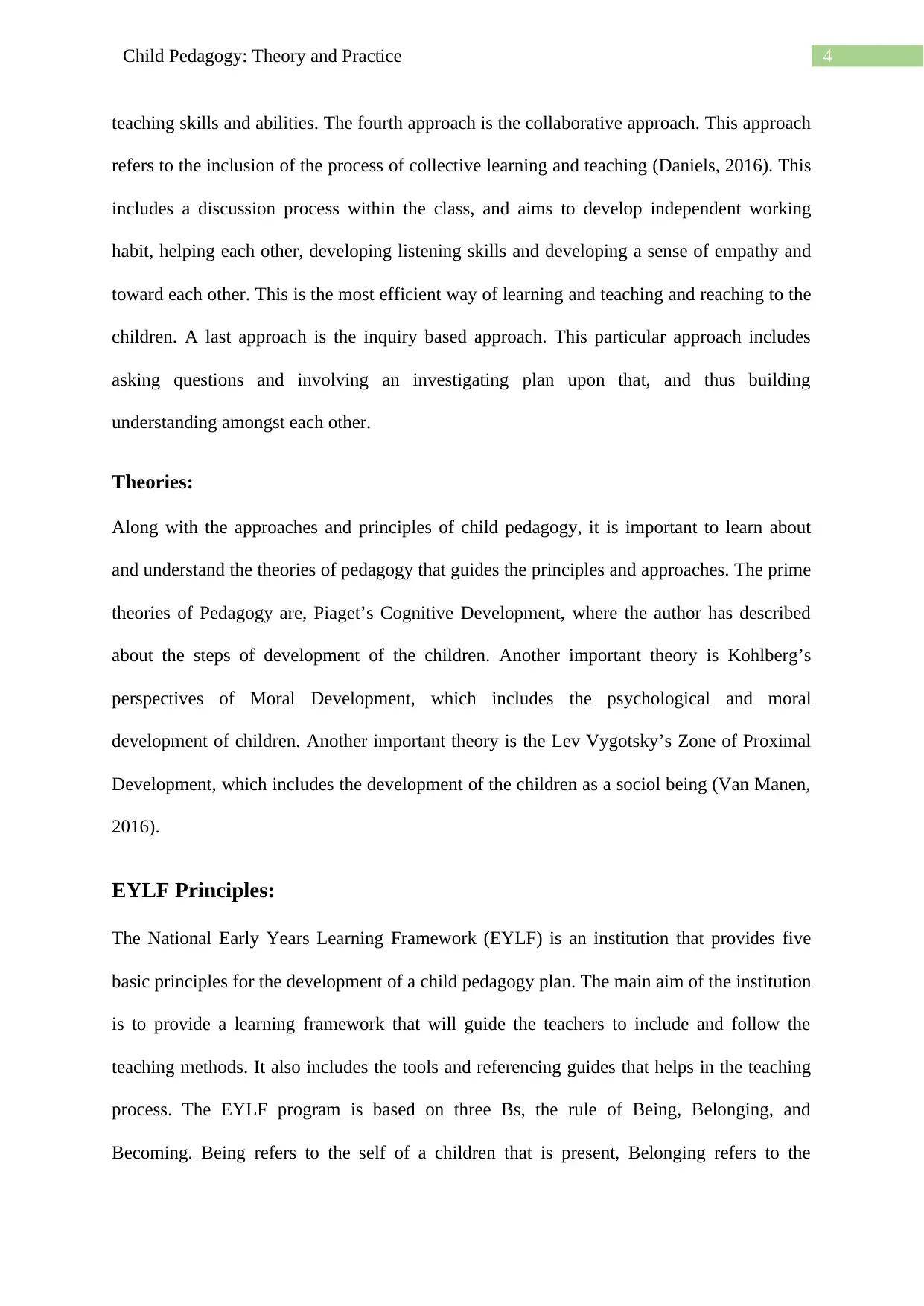
4Child Pedagogy: Theory and Practice
teaching skills and abilities. The fourth approach is the collaborative approach. This approach
refers to the inclusion of the process of collective learning and teaching (Daniels, 2016). This
includes a discussion process within the class, and aims to develop independent working
habit, helping each other, developing listening skills and developing a sense of empathy and
toward each other. This is the most efficient way of learning and teaching and reaching to the
children. A last approach is the inquiry based approach. This particular approach includes
asking questions and involving an investigating plan upon that, and thus building
understanding amongst each other.
Theories:
Along with the approaches and principles of child pedagogy, it is important to learn about
and understand the theories of pedagogy that guides the principles and approaches. The prime
theories of Pedagogy are, Piaget’s Cognitive Development, where the author has described
about the steps of development of the children. Another important theory is Kohlberg’s
perspectives of Moral Development, which includes the psychological and moral
development of children. Another important theory is the Lev Vygotsky’s Zone of Proximal
Development, which includes the development of the children as a sociol being (Van Manen,
2016).
EYLF Principles:
The National Early Years Learning Framework (EYLF) is an institution that provides five
basic principles for the development of a child pedagogy plan. The main aim of the institution
is to provide a learning framework that will guide the teachers to include and follow the
teaching methods. It also includes the tools and referencing guides that helps in the teaching
process. The EYLF program is based on three Bs, the rule of Being, Belonging, and
Becoming. Being refers to the self of a children that is present, Belonging refers to the
teaching skills and abilities. The fourth approach is the collaborative approach. This approach
refers to the inclusion of the process of collective learning and teaching (Daniels, 2016). This
includes a discussion process within the class, and aims to develop independent working
habit, helping each other, developing listening skills and developing a sense of empathy and
toward each other. This is the most efficient way of learning and teaching and reaching to the
children. A last approach is the inquiry based approach. This particular approach includes
asking questions and involving an investigating plan upon that, and thus building
understanding amongst each other.
Theories:
Along with the approaches and principles of child pedagogy, it is important to learn about
and understand the theories of pedagogy that guides the principles and approaches. The prime
theories of Pedagogy are, Piaget’s Cognitive Development, where the author has described
about the steps of development of the children. Another important theory is Kohlberg’s
perspectives of Moral Development, which includes the psychological and moral
development of children. Another important theory is the Lev Vygotsky’s Zone of Proximal
Development, which includes the development of the children as a sociol being (Van Manen,
2016).
EYLF Principles:
The National Early Years Learning Framework (EYLF) is an institution that provides five
basic principles for the development of a child pedagogy plan. The main aim of the institution
is to provide a learning framework that will guide the teachers to include and follow the
teaching methods. It also includes the tools and referencing guides that helps in the teaching
process. The EYLF program is based on three Bs, the rule of Being, Belonging, and
Becoming. Being refers to the self of a children that is present, Belonging refers to the
Paraphrase This Document
Need a fresh take? Get an instant paraphrase of this document with our AI Paraphraser
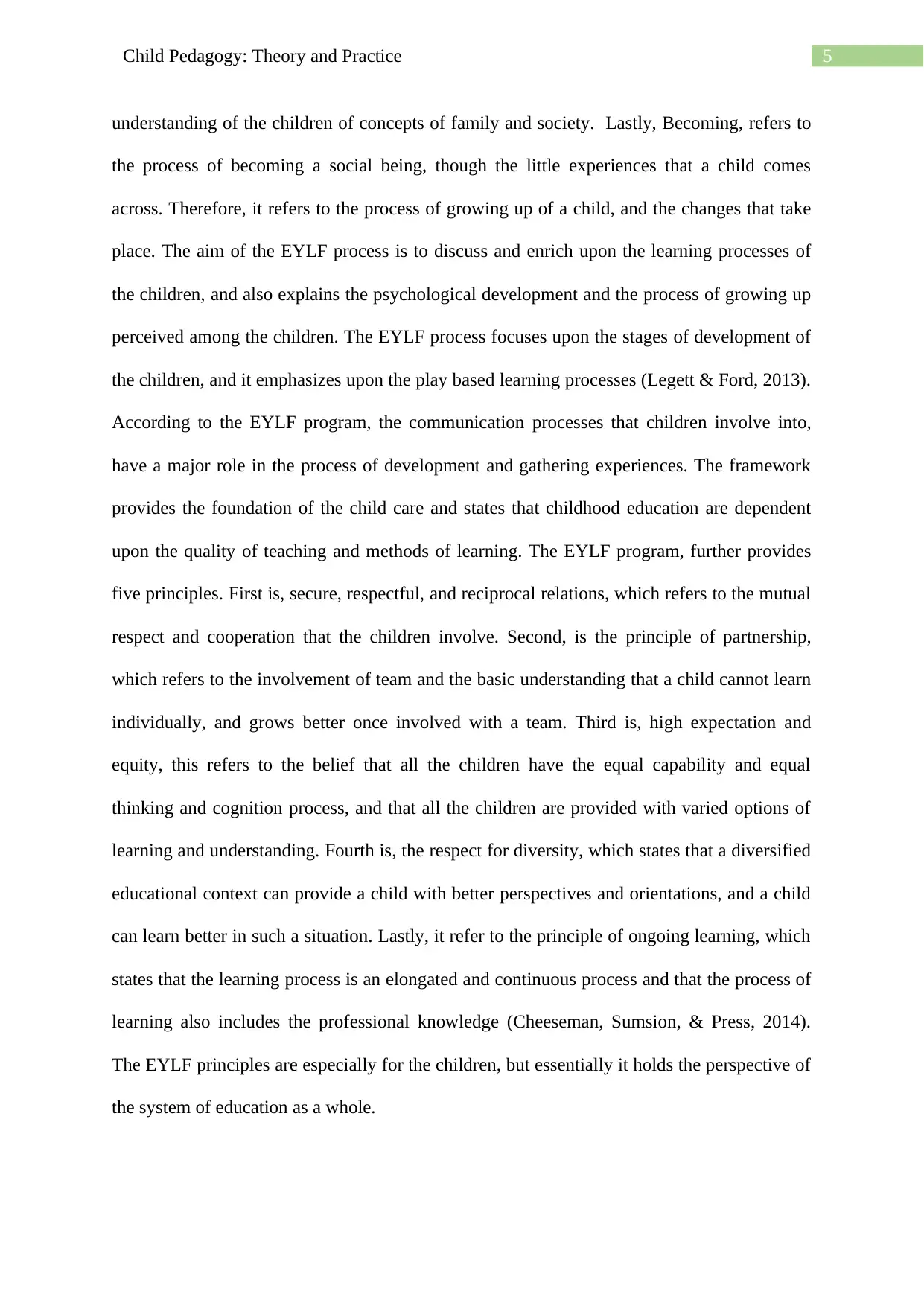
5Child Pedagogy: Theory and Practice
understanding of the children of concepts of family and society. Lastly, Becoming, refers to
the process of becoming a social being, though the little experiences that a child comes
across. Therefore, it refers to the process of growing up of a child, and the changes that take
place. The aim of the EYLF process is to discuss and enrich upon the learning processes of
the children, and also explains the psychological development and the process of growing up
perceived among the children. The EYLF process focuses upon the stages of development of
the children, and it emphasizes upon the play based learning processes (Legett & Ford, 2013).
According to the EYLF program, the communication processes that children involve into,
have a major role in the process of development and gathering experiences. The framework
provides the foundation of the child care and states that childhood education are dependent
upon the quality of teaching and methods of learning. The EYLF program, further provides
five principles. First is, secure, respectful, and reciprocal relations, which refers to the mutual
respect and cooperation that the children involve. Second, is the principle of partnership,
which refers to the involvement of team and the basic understanding that a child cannot learn
individually, and grows better once involved with a team. Third is, high expectation and
equity, this refers to the belief that all the children have the equal capability and equal
thinking and cognition process, and that all the children are provided with varied options of
learning and understanding. Fourth is, the respect for diversity, which states that a diversified
educational context can provide a child with better perspectives and orientations, and a child
can learn better in such a situation. Lastly, it refer to the principle of ongoing learning, which
states that the learning process is an elongated and continuous process and that the process of
learning also includes the professional knowledge (Cheeseman, Sumsion, & Press, 2014).
The EYLF principles are especially for the children, but essentially it holds the perspective of
the system of education as a whole.
understanding of the children of concepts of family and society. Lastly, Becoming, refers to
the process of becoming a social being, though the little experiences that a child comes
across. Therefore, it refers to the process of growing up of a child, and the changes that take
place. The aim of the EYLF process is to discuss and enrich upon the learning processes of
the children, and also explains the psychological development and the process of growing up
perceived among the children. The EYLF process focuses upon the stages of development of
the children, and it emphasizes upon the play based learning processes (Legett & Ford, 2013).
According to the EYLF program, the communication processes that children involve into,
have a major role in the process of development and gathering experiences. The framework
provides the foundation of the child care and states that childhood education are dependent
upon the quality of teaching and methods of learning. The EYLF program, further provides
five principles. First is, secure, respectful, and reciprocal relations, which refers to the mutual
respect and cooperation that the children involve. Second, is the principle of partnership,
which refers to the involvement of team and the basic understanding that a child cannot learn
individually, and grows better once involved with a team. Third is, high expectation and
equity, this refers to the belief that all the children have the equal capability and equal
thinking and cognition process, and that all the children are provided with varied options of
learning and understanding. Fourth is, the respect for diversity, which states that a diversified
educational context can provide a child with better perspectives and orientations, and a child
can learn better in such a situation. Lastly, it refer to the principle of ongoing learning, which
states that the learning process is an elongated and continuous process and that the process of
learning also includes the professional knowledge (Cheeseman, Sumsion, & Press, 2014).
The EYLF principles are especially for the children, but essentially it holds the perspective of
the system of education as a whole.
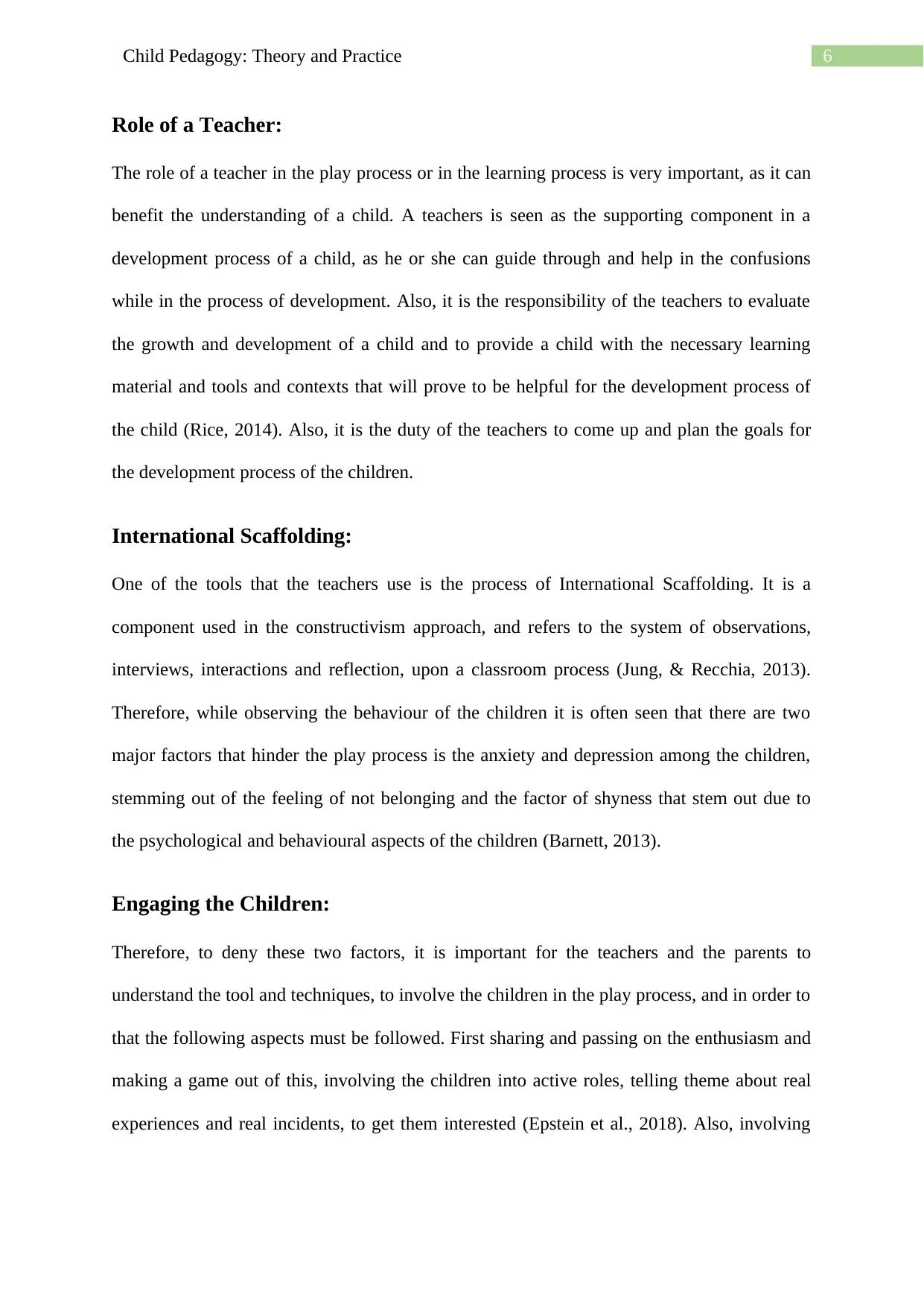
6Child Pedagogy: Theory and Practice
Role of a Teacher:
The role of a teacher in the play process or in the learning process is very important, as it can
benefit the understanding of a child. A teachers is seen as the supporting component in a
development process of a child, as he or she can guide through and help in the confusions
while in the process of development. Also, it is the responsibility of the teachers to evaluate
the growth and development of a child and to provide a child with the necessary learning
material and tools and contexts that will prove to be helpful for the development process of
the child (Rice, 2014). Also, it is the duty of the teachers to come up and plan the goals for
the development process of the children.
International Scaffolding:
One of the tools that the teachers use is the process of International Scaffolding. It is a
component used in the constructivism approach, and refers to the system of observations,
interviews, interactions and reflection, upon a classroom process (Jung, & Recchia, 2013).
Therefore, while observing the behaviour of the children it is often seen that there are two
major factors that hinder the play process is the anxiety and depression among the children,
stemming out of the feeling of not belonging and the factor of shyness that stem out due to
the psychological and behavioural aspects of the children (Barnett, 2013).
Engaging the Children:
Therefore, to deny these two factors, it is important for the teachers and the parents to
understand the tool and techniques, to involve the children in the play process, and in order to
that the following aspects must be followed. First sharing and passing on the enthusiasm and
making a game out of this, involving the children into active roles, telling theme about real
experiences and real incidents, to get them interested (Epstein et al., 2018). Also, involving
Role of a Teacher:
The role of a teacher in the play process or in the learning process is very important, as it can
benefit the understanding of a child. A teachers is seen as the supporting component in a
development process of a child, as he or she can guide through and help in the confusions
while in the process of development. Also, it is the responsibility of the teachers to evaluate
the growth and development of a child and to provide a child with the necessary learning
material and tools and contexts that will prove to be helpful for the development process of
the child (Rice, 2014). Also, it is the duty of the teachers to come up and plan the goals for
the development process of the children.
International Scaffolding:
One of the tools that the teachers use is the process of International Scaffolding. It is a
component used in the constructivism approach, and refers to the system of observations,
interviews, interactions and reflection, upon a classroom process (Jung, & Recchia, 2013).
Therefore, while observing the behaviour of the children it is often seen that there are two
major factors that hinder the play process is the anxiety and depression among the children,
stemming out of the feeling of not belonging and the factor of shyness that stem out due to
the psychological and behavioural aspects of the children (Barnett, 2013).
Engaging the Children:
Therefore, to deny these two factors, it is important for the teachers and the parents to
understand the tool and techniques, to involve the children in the play process, and in order to
that the following aspects must be followed. First sharing and passing on the enthusiasm and
making a game out of this, involving the children into active roles, telling theme about real
experiences and real incidents, to get them interested (Epstein et al., 2018). Also, involving
⊘ This is a preview!⊘
Do you want full access?
Subscribe today to unlock all pages.

Trusted by 1+ million students worldwide
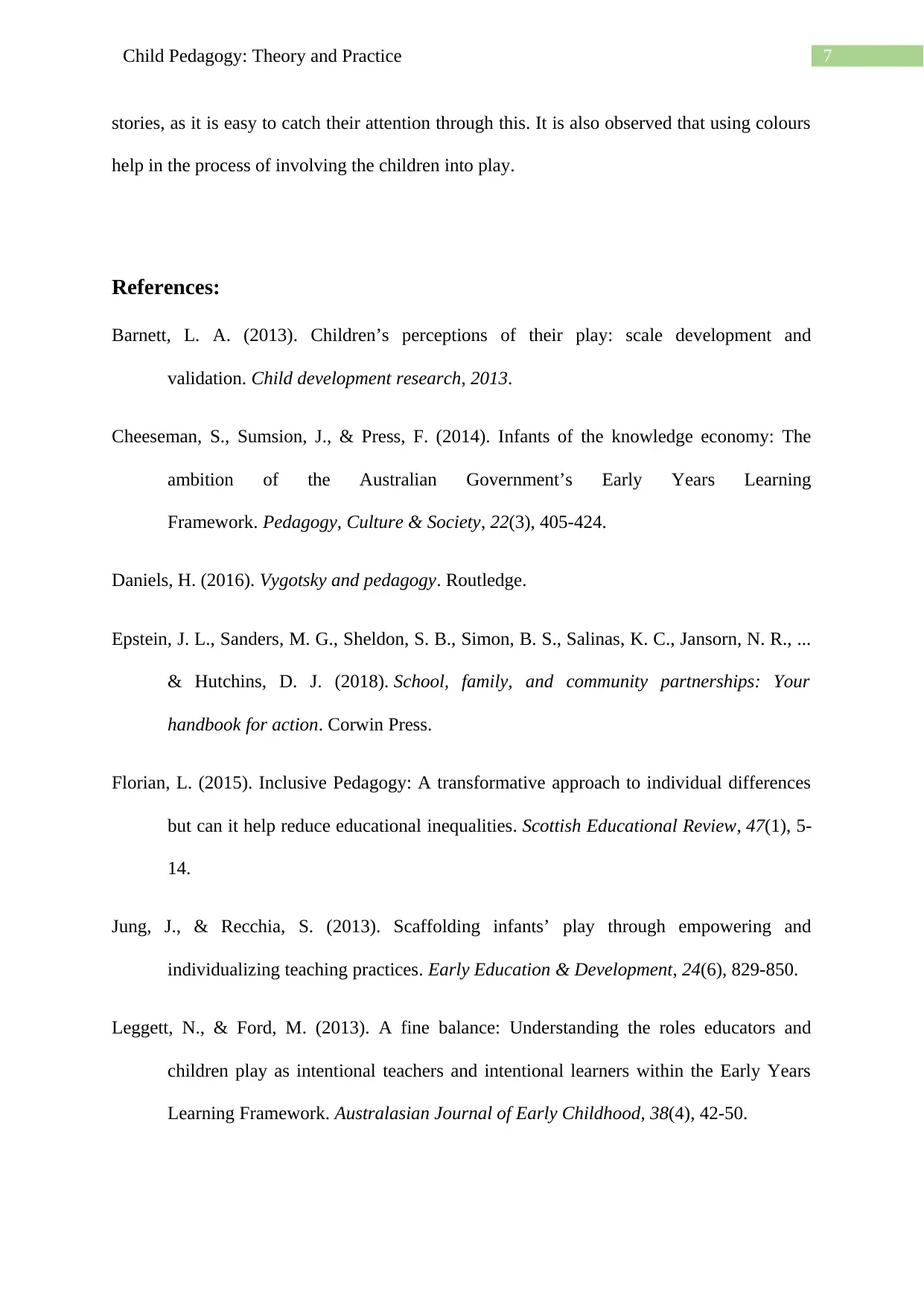
7Child Pedagogy: Theory and Practice
stories, as it is easy to catch their attention through this. It is also observed that using colours
help in the process of involving the children into play.
References:
Barnett, L. A. (2013). Children’s perceptions of their play: scale development and
validation. Child development research, 2013.
Cheeseman, S., Sumsion, J., & Press, F. (2014). Infants of the knowledge economy: The
ambition of the Australian Government’s Early Years Learning
Framework. Pedagogy, Culture & Society, 22(3), 405-424.
Daniels, H. (2016). Vygotsky and pedagogy. Routledge.
Epstein, J. L., Sanders, M. G., Sheldon, S. B., Simon, B. S., Salinas, K. C., Jansorn, N. R., ...
& Hutchins, D. J. (2018). School, family, and community partnerships: Your
handbook for action. Corwin Press.
Florian, L. (2015). Inclusive Pedagogy: A transformative approach to individual differences
but can it help reduce educational inequalities. Scottish Educational Review, 47(1), 5-
14.
Jung, J., & Recchia, S. (2013). Scaffolding infants’ play through empowering and
individualizing teaching practices. Early Education & Development, 24(6), 829-850.
Leggett, N., & Ford, M. (2013). A fine balance: Understanding the roles educators and
children play as intentional teachers and intentional learners within the Early Years
Learning Framework. Australasian Journal of Early Childhood, 38(4), 42-50.
stories, as it is easy to catch their attention through this. It is also observed that using colours
help in the process of involving the children into play.
References:
Barnett, L. A. (2013). Children’s perceptions of their play: scale development and
validation. Child development research, 2013.
Cheeseman, S., Sumsion, J., & Press, F. (2014). Infants of the knowledge economy: The
ambition of the Australian Government’s Early Years Learning
Framework. Pedagogy, Culture & Society, 22(3), 405-424.
Daniels, H. (2016). Vygotsky and pedagogy. Routledge.
Epstein, J. L., Sanders, M. G., Sheldon, S. B., Simon, B. S., Salinas, K. C., Jansorn, N. R., ...
& Hutchins, D. J. (2018). School, family, and community partnerships: Your
handbook for action. Corwin Press.
Florian, L. (2015). Inclusive Pedagogy: A transformative approach to individual differences
but can it help reduce educational inequalities. Scottish Educational Review, 47(1), 5-
14.
Jung, J., & Recchia, S. (2013). Scaffolding infants’ play through empowering and
individualizing teaching practices. Early Education & Development, 24(6), 829-850.
Leggett, N., & Ford, M. (2013). A fine balance: Understanding the roles educators and
children play as intentional teachers and intentional learners within the Early Years
Learning Framework. Australasian Journal of Early Childhood, 38(4), 42-50.
Paraphrase This Document
Need a fresh take? Get an instant paraphrase of this document with our AI Paraphraser
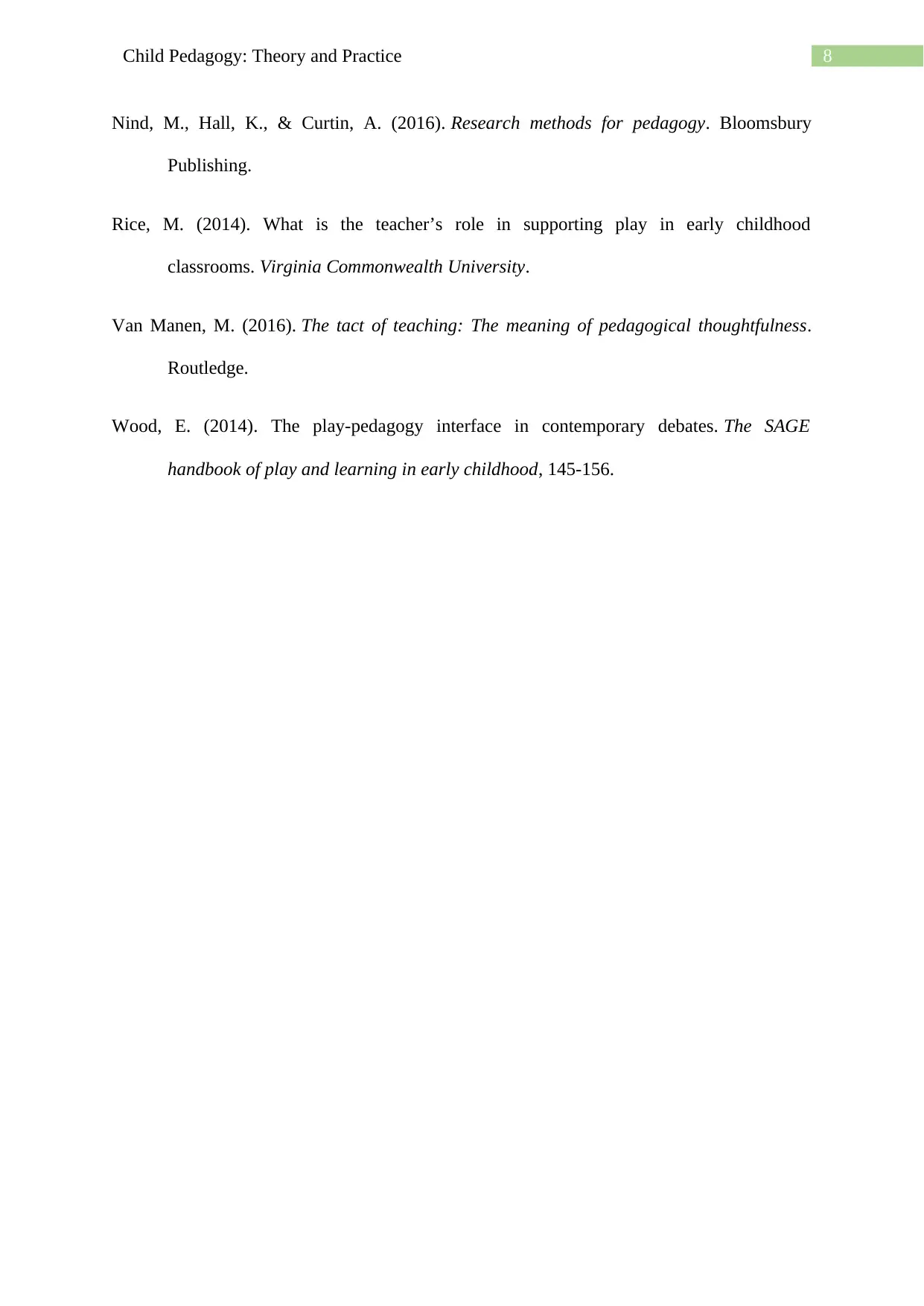
8Child Pedagogy: Theory and Practice
Nind, M., Hall, K., & Curtin, A. (2016). Research methods for pedagogy. Bloomsbury
Publishing.
Rice, M. (2014). What is the teacher’s role in supporting play in early childhood
classrooms. Virginia Commonwealth University.
Van Manen, M. (2016). The tact of teaching: The meaning of pedagogical thoughtfulness.
Routledge.
Wood, E. (2014). The play-pedagogy interface in contemporary debates. The SAGE
handbook of play and learning in early childhood, 145-156.
Nind, M., Hall, K., & Curtin, A. (2016). Research methods for pedagogy. Bloomsbury
Publishing.
Rice, M. (2014). What is the teacher’s role in supporting play in early childhood
classrooms. Virginia Commonwealth University.
Van Manen, M. (2016). The tact of teaching: The meaning of pedagogical thoughtfulness.
Routledge.
Wood, E. (2014). The play-pedagogy interface in contemporary debates. The SAGE
handbook of play and learning in early childhood, 145-156.
1 out of 8
Related Documents
Your All-in-One AI-Powered Toolkit for Academic Success.
+13062052269
info@desklib.com
Available 24*7 on WhatsApp / Email
![[object Object]](/_next/static/media/star-bottom.7253800d.svg)
Unlock your academic potential
Copyright © 2020–2025 A2Z Services. All Rights Reserved. Developed and managed by ZUCOL.





